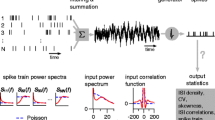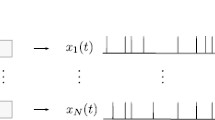Summary
Recent electrophysiological studies of the activity in response to acoustic stimuli of single primary afferent neurons in the VIIIth nerve of mammals strongly suggest that the spike activity is inherently stochastic in that
-
a)
the detailed pattern of activity varies unpredictably from repetition to repetition of an identical acoustic wave-form, but
-
b)
appropriate averages of this activity show stability or statistical regularity.
Since the only way in which auditory information can reach the more central parts of the nervous system is via the VIIIth nerve, the effective “neural noise” implied by such stochastic “coding” of auditory information must set some sort of limits on auditory discriminations. As shown in this paper, these limits can be calculated if an appropriate statistical model of the neural activity is accepted. Of course, no more than a bound on discrimination performance can be determined in this way, since there is no reason to suppose that the central processing in the nervous system is effectively ideal — particularly in the artificial situations of auditory psychophysics. But if these bounds closely approximate performance (and there is some reason to believe they may, at least for the very simple auditory discriminations treated in this paper) then it seems reasonable to maintain that the observed stochastic “coding” in a sense accounts for or explains these behavioral limits.
The key to such an analytical effort as proposed here is the availability of sufficient data on the activity in single primary afferent fibers to permit one to infer a reasonable statistical model describing the total (spike) activity in all the tens of thousands of acoustic fibers of the VIIIth nerve in response to the signals of interest. In spite of extensive studies of single-fiber activity by a number of observers, highfrequency tone bursts (several kilocycles or more) are one of the few classes of signals for which an even roughly adequate amount of data exists at present. For such signals the data suggest that the firing pattern of each neuron can be modeled as a sample function from a simple stationary random process whose parameters depend on stimulus frequency, tensity, cochlear location, neuron sensitivity, etc. The desired overall model can then be obtained by assuming reasonable distributions for these parameters over the population of neurons.
Given such a model for the pattern of activity in the auditory nerve, discriminations between tone bursts of different frequencies or different intensities can be studied. These differences will be reflected in the properties of the random processes characterizing the auditory nerve. Using the theory of statistical hypothesis testing, it is possible to determine the smallest difference which could be reliably discriminated by an ideal computer examining the total activity of all fibers. As will be shown, the performance of this ideal computer parallels in a number of ways the performance of human observers. The general trends of this performance, moreover, (including an effect similar to Weber's Law) are largely insensitive to the details of the random process model for the neuron activity. However, it is interesting that the functioning of the ideal computer is particularly and uniquely simple for precisely that class of random process models which seems best to represent the physiological data.
Similar content being viewed by others
References.
Kiang, N. Y-s., T. Watanabe, E.C. Thomas, and L.F. Clark: Stimulus coding in the cat's auditory nerve. Ann. Otol. (St. Louis) 71, 1009 (1962). See also: Theelectrical activity of single fibers in the auditory nerve of cats, N. Y-s. Kiang in collaboration with T. Watanabe, E.C. Thomas and L. F. Clark, to be published.
Davis, H.: Peripheral coding of auditory information. In: (W.A. RosenBlith ed.), Sensory communication, p. 119–141, Cambridge (Mass.): M.I.T. Press (1961).
Katsuki, Y.: Neural mechanism of auditory sensation in cats. In: W. A. Rosenblith (ed.), Sensory communication, p. 561–583, op. cit.
Davis, H: Advances in the neurophysiology and neuroanatomy of the cochlea. J. acoust. Soc. Amer. 34, 9, (Pt. 2), 1377–1385 (Sept. 1962).
Weiss, T.F.: A model for firing patternsof auditory nerve fibers, T.R. 418, Research laboratory of electronics, Mass. Institute of Technology, Cambridge (Mass.), (March 2, 1964).
Siebert, W.M., and P. R. Gray: Random process model for the firing pattern of single auditory neurons, Quarterly Progress Report, No. 71, Research Laboratory of Electronics, Mass. Institute of Technology, Cambridge, (Mass.), (October 15, 1963), p. 241–5.
Parzen E.: Stochastic processes. San Francisco: Holden-Day: (1962).
Békésy, G.: Experiments in hearing. New York: McGraw-Hill Book Co. (1960).
Cramer, H.: Mathematicalmethods of statistics. Princeton: Princeton University Press (1951).
Swets, J.A. (ed.): Signal detection and recognition of human observers: Contemporary Readings. New York: John Wiley & Sons (1964).
Author information
Authors and Affiliations
Additional information
Supported in part by the U.S. Army, Navy, and Air Force under contract DA 36-039-AMC-03200 (E); National Science Foundation (Grant GP-2495) the National Institutes of Health (Grant MH-04737-04), the National Aeronautics and Space Administration (NsG-496).
Rights and permissions
About this article
Cite this article
Siebert, W.M. Some implications of the stochastic behavior of primary auditory neurons. Kybernetik 2, 206–215 (1965). https://doi.org/10.1007/BF00306416
Received:
Issue Date:
DOI: https://doi.org/10.1007/BF00306416




